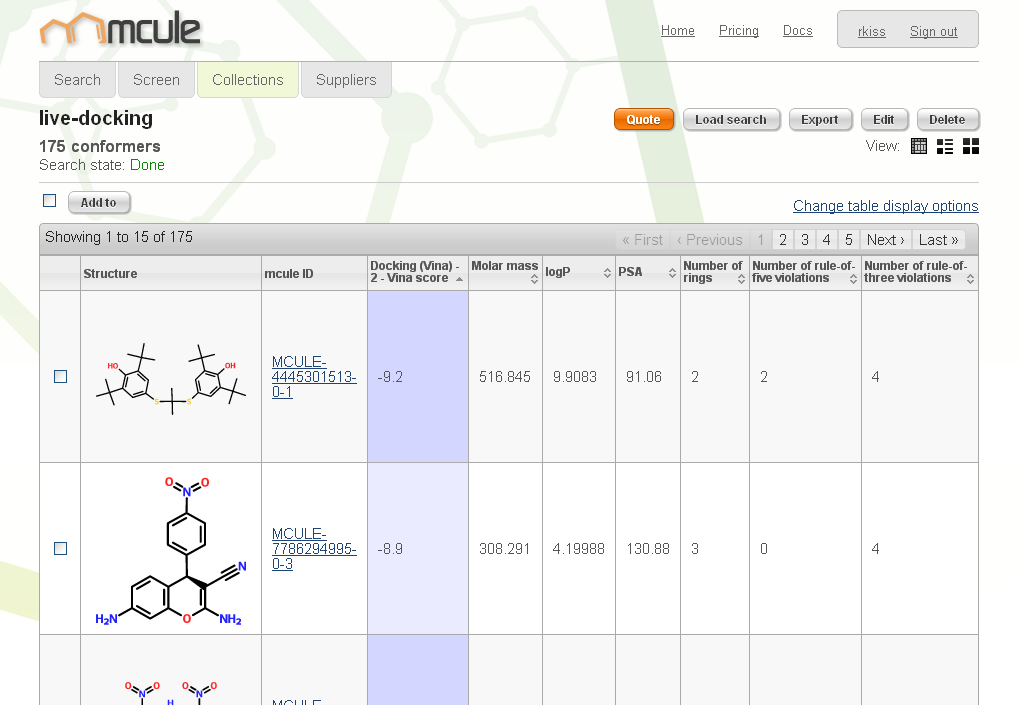After the first release of mcule, which included basic searching functionalities, we have been working hard on the integration of several new features. I'm pleased to introduce:
Docking (Vina)
Yes! Docking is part of the release pack, and we believe that this will really make a difference! There are a few docking servers available on the net, but have you ever heard about live-docking? Check this out:
After you launched the docking you can start browsing the results as soon as the first few calculations are finished.
One other cool functionality is that you can select your target from among ~10k PDB structures prepared for docking. Many thanks for the group of Prof. Didier Rognan for allowing the integration of sc-PDB [Meslamani J, Rognan D, Kellenberger E. sc-PDB: a database for identifying variations and multiplicity of 'druggable' binding sites in proteins. Bioinformatics. 2011 May 1;27(9):1324-6.] with mcule. This is a great benefit for our users as you can now directly select targets by searching for PDB ID, Protein name, Organism name, UniProt Name/Accession ID/Taxonomic ID. The centre of the binding site will be also automatically determined based on the position of the co-crystallized ligand. All these protein structures have been automatically prepared for docking. Besides selecting your macromolecule from the sc-PDB database, you can upload your own structures as well.
For docking, we use the latest version of the open-source docking tool AutoDock Vina [Trott O, Olson AJ. AutoDock Vina: improving the speed and accuracy of docking with a new scoring function, efficient optimization, and multithreading. J Comput Chem. 2010 Jan 30;31(2):455-61.]. We were quite satisfied with Vina in the past, as it was involved in our GPCR fragment library design protocol, which yielded 100% hit rate.
Property
There is a property filter, where you can set minimum and maximum boundaries. Available properties are either calculated from the InChI string (molar mass, number of atoms, heavy atoms, hydrogens, heteroatoms, stereocentres, cis-trans double bonds), or by OpenBabel (logP, PSA, molar refractivity, number of rings, rotatable bonds, H-bond donors, H-bond acceptors) [O'Boyle NM, Banck M, James CA, Morley C, Vandermeersch T, Hutchison GR. Open Babel: An open chemical toolbox. J Cheminform. 2011 Oct 7;3:33.]. Besides these, rule-of-five and rule-of-three violations are also calculated.
Table View
We have designed a new view, which makes browsing the results even more efficient.
In the new table view you can set which properties (including screening results, e.g. docking scores) you would like to display. Now, you might have seen molecule databases displayed in a useful and transparent way on the web before (there are not many good examples though), but I doubt you have ever been able to sort that database as blindingly fast as you can from now at mcule.com. Believe it or not, sorting of many hundreds of thousands or even millions of molecules can be done in a few seconds(!). Remember that you are using a website and not a desktop application.
Sampler
There is another filter, called Sampler. It can be used to cut the database at a certain threshold and retain only the top x number of molecules. By default it retains the top molecules highest ranked by the previous filter, but it can be set to sample the molecule collection randomly.
It is also important to mention that more advanced features are provided for free with some limitations. The maximum number of molecules for docking is currently set to 500 per month. Sampler is an efficient way to reduce the number of input molecules for such limited filters. We will provide subscriptions with much less boundaries on the website soon. Until then, contact us if you need more!
It is also important to mention that more advanced features are provided for free with some limitations. The maximum number of molecules for docking is currently set to 500 per month. Sampler is an efficient way to reduce the number of input molecules for such limited filters. We will provide subscriptions with much less boundaries on the website soon. Until then, contact us if you need more!
OK. So now you can go and do some docking if you like, but remember that many other features are underway, so there is more to come! Keep looking at this blog for more!







